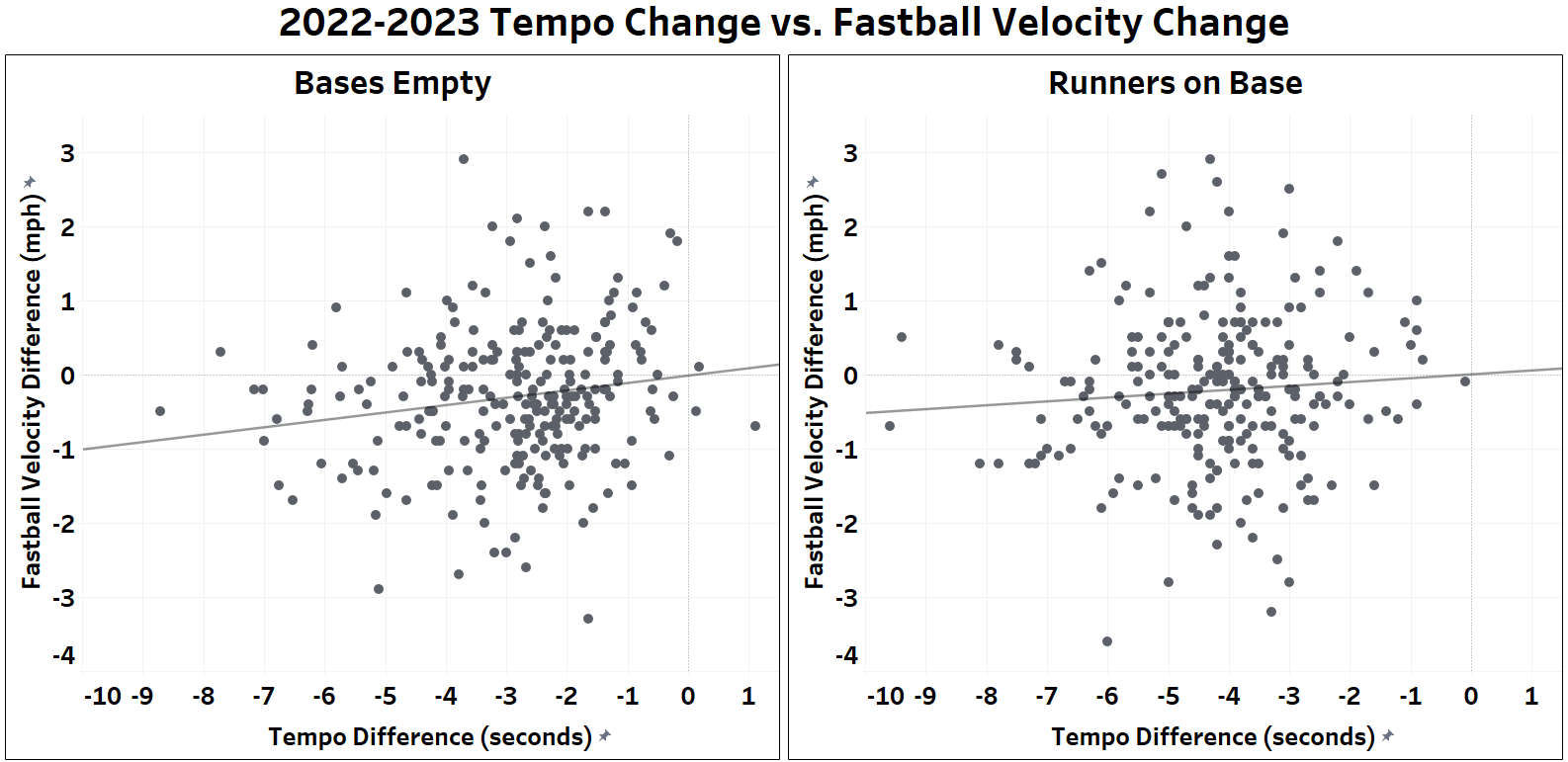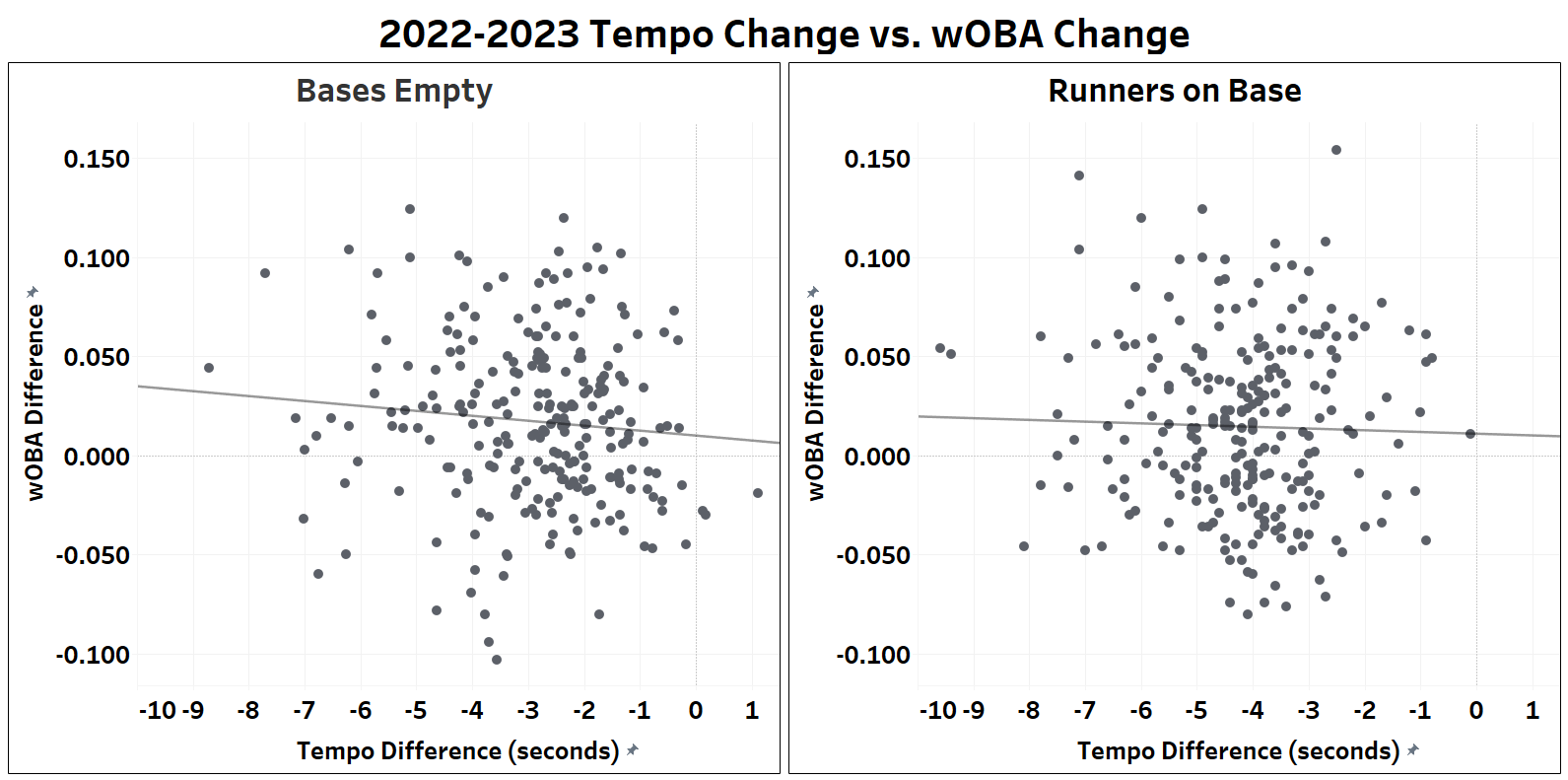The 2023 rule changes were a huge success in year one: the average length of games improved by almost 30 minutes, attendance rose 8%, and there was more in-game action (stolen bases and non-shift limited hits). The biggest pure change to the play-by-play of the game was the pitch clock, which limited pitchers to 15 seconds to deliver a pitch with the bases empty and 20 seconds with runners on.
Although the pitch clock got harsh criticism early in the year, violations were largely a non-factor throughout the season. The Mets had the most violations with 55, which is about a violation every third game.
One of the biggest questions lingering about the pitch clock was how pitchers would react to it. The clock required most pitchers to significantly decrease their time between pitches, which could harm pitchers. Previous studies have suggested that the pitch clock could increase pitcher injuries. Still, rising velocity and other factors make it too difficult to single out the pitch clock as a key factor.
In June, MLB released an article stating no clear correlation between the pitch clock and injuries. Injuries were slightly up from 2022 but below 2021, and many of those injured were previously injured.
However, I was curious to know if there was a learning curve to the pitch clock. That is, did those who were close to the pitch clock’s limits adjust more easily to the new constraints and vice versa? Or did it not have as big of a difference as it may appear?
Methodology
Pitchers who threw a minimum of 300 pitches in both 2022 and 2023 were included in the dataset, which amounted to 248 pitchers in total. “Tempo” is officially what MLB calls the time between pitches, as their clock starts when the pitcher releases one pitch and ends when the pitcher releases the next pitch. Any difference mentioned is the difference between 2022 (pre-pitch clock) and 2023 (with pitch clock).
Tempo & Velocity
My first thought is that the pitch clock would affect velocity the most. Players have less time to rest in between pitches, so they would not be able to recover their full energy as compared to pre-pitch clock times. Since the clock changes based on whether runners are on base, there are two different charts. Overall, pitchers cut down from 2022 by 2.9 seconds with the bases empty and 4.2 seconds with runners on. The average fastball velocity decreased by 0.3 mph with the bases empty and decreased by 0.2 with runners on.

For both bases empty and runners on base, there was a positive correlation between those who already had quick tempos and their velocity either maintaining or improving from 2022. That means that those who were quick to the plate already had less of a problem adjusting to the pitch clock. There was a stronger correlation when the bases were empty compared to runners on, which is likely due to pitchers being able to operate at their own pace with no one on.
Additionally, those who had to make a big change (i.e. five seconds or more) saw harsher velocity decreases than those who did not have to make as big of a change. Of the 26 pitchers who improved by five or more seconds, 22 of them lost fastball velocity from 2022 to 2023 (or 85%). Among all other pitchers who improved by less than five seconds, only 65% lost fastball velocity. While the pitch clock is not the only factor when it comes to velocity, it does have an impact on every single pitch.
With runners on base, it was more of a cluster and less of a correlation between tempo improvements and velocity improvements. Although the average tempo change was greater with runners on base, 10 more pitchers (4%) gained velocity with runners on than the bases empty.
On the big adjustment side, Giovanny Gallegos, Devin Williams, and Josh Hader were all standouts of those who improved their tempo significantly but lost velocity. Gallegos stood alone with an 8.7-second improvement with the bases empty and a 9.6-second improvement with runners on, all while he lost around 0.5 mph. Devin Williams improved his tempo by 7.2 seconds and only lost 0.2 mph with the bases empty, but improved his tempo by 9.4 seconds and gained 0.5 mph with runners on. Josh Hader lost velocity in all situations while being top 7 in improved tempo.
Among those who did not have to adjust much, George Kirby, José Berríos, and Nick Pivetta all gained velocity while having a negligible change in tempo from 2022 (Berrios actually gained 0.2 seconds in tempo).
Tempo & wOBA
Although fastball velocity seems like the biggest part of the new pitch clock rule, I was also curious if there was any correlation between tempo and pitchers’ wOBA. Even more so than fastball velocity, a plethora of factors go into a pitcher’s wOBA. Despite that, there is enough of a sample to identify a correlation (and not causation) between the pitch clock and results. Again, there are two graphs: one for bases empty and one for runners on.

There is a slight negative correlation between those who had less of a tempo change and their wOBA between 2022-2023, both with the bases empty and runners on (albeit with runners on is negligible). Both of these show that pitchers who were already quick in their deliveries were more likely to improve their results than those who had to change their tempo significantly. Similar to the tempo & velocity charts, the correlation is stronger with the bases empty than with runners on.
As for standouts on the tempo and wOBA chart (bases empty), José Berríos and Logan Gilbert both slightly improved their tempo while seeing a drop in their wOBA. Others who had smaller tempo changes and improved their wOBA include Reid Detmers, Kyle Bradish, Nick Pivetta, and Logan Webb.
On the other side, those who had large changes to their tempo and saw their wOBA go up were Giovanny Gallegos, Andrés Muñoz, and Shohei Ohtani. More relievers appeared on the big tempo change/big wOBA decrease than starters did.
Takeaways
The shift from no pitch clock to a pitch clock will not happen again (unless Rob Manfred wants chaos), so these changes only affected the 2023 season. This is still a useful retrospective to the new rules, which seldom happen in any sport. The pitch clock had a tangible effect on the game for most pitchers, which means we will continue to see these results for the foreseeable future. The on-base clock has also changed for the 2024 season, from 20 to 18 seconds.
Going forward, monitoring pitchers who already struggled with adjusting to the clock could be useful to see if their results or health deteriorates more quickly due to the sudden change in their pitching rhythm. Furthermore, seeing who adjusted well can identify who is adaptable on the mound, a skill that can indicate success outside of pure talent.
Photos courtesy of Icon Sportswire | Adapted by Aaron Polcare (@bearydoesgfx on X)

K% and BB% changes?